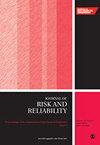Multisensor information fusion method for intelligent fault diagnosis of reciprocating compressor in shale gas development
IF 1.8
4区 工程技术
Q3 ENGINEERING, INDUSTRIAL
Proceedings of the Institution of Mechanical Engineers Part O-Journal of Risk and Reliability
Pub Date : 2022-11-27
DOI:10.1177/1748006x221136582
引用次数: 0
Abstract
To address the problems of the poor feature extraction ability and weak data generalization ability of traditional fault diagnosis methods in reciprocating shale gas compressor fault diagnosis applications, in this study, a fault diagnosis method for reciprocating shale gas was developed. This method uses a novel optimized learning method, free energy in persistent contrastive divergence, in deep belief network learning and training. It solves the problem of the deep belief network classification ability degradation in long-term training. The root mean square error is used as the fitness function to search for the optimal parameter combination of the DBN network by using the sparrow search algorithm. At the same time, the learning rate and batch size of the deep belief network, which have a large impact on the training error, are selected for optimization. Then, the original vibration signal is preprocessed by calculating 13 different time domain indicators, and feature-level data and decision-level data are fused in a parallel superposition method to obtain a fused time domain index dataset. Finally, combined with the powerful adaptive feature extraction and nonlinear mapping ability of deep learning, the constructed sample dataset is input to the deep belief network for training, and the deep belief network based on reciprocating shale gas compressor fault diagnosis model is established.页岩气开发往复式压缩机智能故障诊断的多传感器信息融合方法
针对传统故障诊断方法在往复式页岩气压缩机故障诊断应用中特征提取能力差、数据泛化能力弱的问题,本研究开发了一种往复式页岩气压缩机故障诊断方法。该方法采用了一种新颖的优化学习方法——持续对比发散中的自由能,用于深度信念网络的学习和训练。解决了深度信念网络在长期训练中分类能力下降的问题。以均方根误差作为适应度函数,利用麻雀搜索算法搜索DBN网络的最优参数组合。同时,选取对训练误差影响较大的深度信念网络的学习率和批处理大小进行优化。然后,通过计算13种不同的时域指标对原始振动信号进行预处理,并采用并行叠加的方法对特征级数据和决策级数据进行融合,得到融合的时域指标数据集。最后,结合深度学习强大的自适应特征提取和非线性映射能力,将构造好的样本数据集输入深度信念网络进行训练,建立基于往复式页岩气压缩机故障诊断模型的深度信念网络。
本文章由计算机程序翻译,如有差异,请以英文原文为准。
求助全文
约1分钟内获得全文
求助全文
来源期刊

Proceedings of the Institution of Mechanical Engineers Part O-Journal of Risk and Reliability
ENGINEERING, MULTIDISCIPLINARY-ENGINEERING, INDUSTRIAL
CiteScore
4.50
自引率
19.00%
发文量
81
审稿时长
6-12 weeks
期刊介绍:
The Journal of Risk and Reliability is for researchers and practitioners who are involved in the field of risk analysis and reliability engineering. The remit of the Journal covers concepts, theories, principles, approaches, methods and models for the proper understanding, assessment, characterisation and management of the risk and reliability of engineering systems. The journal welcomes papers which are based on mathematical and probabilistic analysis, simulation and/or optimisation, as well as works highlighting conceptual and managerial issues. Papers that provide perspectives on current practices and methods, and how to improve these, are also welcome
 求助内容:
求助内容: 应助结果提醒方式:
应助结果提醒方式:


